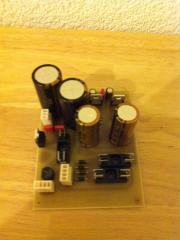-
Posts
1,184 -
Joined
-
Last visited
-
Days Won
30
Content Type
Profiles
Forums
Blogs
Gallery
Everything posted by Altitude
-
everything I have ever ordered from ponoko has had the paper on it but it really makes little difference since the edges of the infill always come out REALLY rough and once you start cleaning it gets everywhere anyway. Those pics above are from a post on another site and I didnt take finished pics, you can get it all off. I do white textured with black infill regularly
-
yeah, overnight. The longer you wait, the more difficult it is to thin out so I dont go overboard with the dry time. I made the mistake of leaving a panel with paint on for a week and it was a pain to get it cleaned up. I use a LOT of paint (several coats worth) to make sure that the engraving is filled and use a soaked lint free wipe with the thinner before wiping with IPA. I think the next time I will do this (next week actually) I want to try actually rinsing the part with IPA using a squirt bottle instead of wiping
-
^ I came to the exact same conclusion. It takes a minute to get it right technique wise but you can pretty much get it all off: *WB Wilba
-
I like enamel paint (like model airplane stuff) cleans up with the paint thinner
-

Beta Test: MIOS32 Bootloader v1.009 could solve USB issues under Windows
Altitude replied to TK.'s topic in MIDIbox SEQ
So far so good. I'll run it through the paces here this wkend. Could this have an influence on the USB MSD functionality? IIRC I could never get that to work right but its fine after the update -
If you want to power it directly from the mains you will need a transformer somewhere. There isnt enough space in the pactec case for one but you could use a 15V DC wall wart (or 12V for the 9V powered sids) and rewire the PSU section to run off one voltage
-
Man, the more I think about this, the more I realize that this is pretty much done. The x0xb0x case I designed will be the exactly the same size as whats needed here, all I need to do is cut and paste the holes on the 6582 front panel and rear panel . How tall were your sides? (i.e. how thick is the case)
-
Good to know. Didn't even think of that. I guess the 0.1" spaced ribbon would be better here than on the Pactec case. I replaced that stuff with wire leads on mine since It was breaking from opening and closing the case (and yes, that was a ton of work too). Are there dimensions for the boards available somewhere or did you just use the hole spacing from the pactec spec sheet?
-
understood :), figured as much with those flat tops.. How did you do the interconnects between the boards? That's really what I'm interested in. I was considering doing the SIL type connections like in the Shruthi
-
Nice.. I'd love to see a nudie pic with top (or bottom) and side off. I've been bouncing around the idea of doing a metal case for mine via FPE and this gives me motivation to do so.. If you want a ponoko tutorial, schrab already did it: http://mutable-instruments.net/forum/discussion/1520/getting-started-with-case-design#Item_31
-
-
For anyone that will be powering off mains (or plans on running off DC or USB), one thing I recommend is to use a DPDT rocker switch. Wire each side as a mirror image to the other for power from USB or the mains transformer, this way you can ONLY use one or the other. I just used a generic power entry module (the one with the switch and IEC connector) and just replace the SPST switch with a DPDT one. All the ones I've seen use a generic snap in switch that just pops out if you want to change it.
-
Here they are: LPC17 layout The way this is designed to be mounted is via 2-56 threaded screws and the midi sockets that have 3 holes in them (CUI SDS-50J. The screws tap into the connector and it looks sharp. Obviously they can be omitted if the boards will be on standoffs. I also included a hole for the dummy midi socket on the IIc board to be used for dinsync
-
thats for the STM core, not the current LPC one although it should be spaced the same and should fit if you didnt use the magjack. PM your email and I'll send you my files, I just did a SEQV4 based on the LPC core and the 4xIIC modules. I also used the dummy slot in the 4xIIC module as a DINSYNC port..
-
you know, if you're going towards +/- 5V, you can easily generate that from a positive DC source by using a LT1054 and a 7805/7905 vRegs (like the shruthi). This would get eliminate the need for a complicated power source..
-
6n136 is kinda weak, you want something that has more gain. 6n137 with a 10k pull up works for me, the 6N139 is the standard in the MHBP cores. You could also try a different brand 6N136 (this helped me with my 3030s which the same issue, I had a fairchild part in there and replacing it with a avago fixes it) The buffer circuit is to shift the level on the analog gates, it has nothing to do with the midi section unless you plan on adding midi ports 3 and 4 the 3.3v thing is not really the core problem, you would probably issues with other 5v devices as well that send out a bit of a rounded square that gets rounded off a bit more by the crappy opto to the point that the uC does recognize it as a valid msg
-
out of curiosity, has anything been changed with these chips (a revision?), its been a while..
-
whats wrong with laser cut ponoko ones and snapping them in? You just need to get them cut at different sizes and just pick the ones that fit best. I did this for my MB seq and it was 6$ for 8 windows
-
I guess a better question is how do i validate the filter portion is NOT broken. The chips that I have to to test look old, they havent been desoldered but the underside looks a little suspicious (made in Korea? never seen those) and have a QC sticker that is way newer than the chip. I dont really have an objective test procedure, the chips all behave the same way on the rig but not like the 6582s I have in my box. This isnt the first time i've done this for ppl but my concern is that I dont know if I am really testing enough, I've come across enough bad sid chips and a bad one is pretty obvious and I can tell if it works or not but the definition of "works" is what I am concerned with. My experience so far has been with the newer chips (8580/6582) and its become hard to distinguish "bad" from "flawed" with the older chips
-
I am testing a batch for a friend and was wondering what are peoples criteria for checking out if a SID is good or not? My 6582 has 6582 chips and the ones he sent me are all 6581s so I am using just a core and a R3A sid board to test with. I'm looking for a way to test the filter but cant seem to get the chip to respond to CC 4 and 5
-

anyone using this programmer? K150 ICSP
Altitude replied to petrol vendor's topic in MIDIbox Tools & MIOS Studio
I had one, support was limited and its no longer being worked on so no newer chips. I got a pickit2 clone to replace it which was $13 like this -
I've tried a bunch of fans, both 12V and 5V powered and they all do it in some degree. The best way to deal with it is a bunch of capacitors on the power line of the fan (100n ceramic followed by a 10uF and 470 uF electolytics pretty much silenced mine)
-
you can get the noise down by adding caps to the powerline to the fan. i also added a switch to turn it off. fan wont really do much without vents in the case
-
AD no longer makes the SSM2164, dont pay extravagant prices for it, the cool audio is the same thing and those are $2.80


